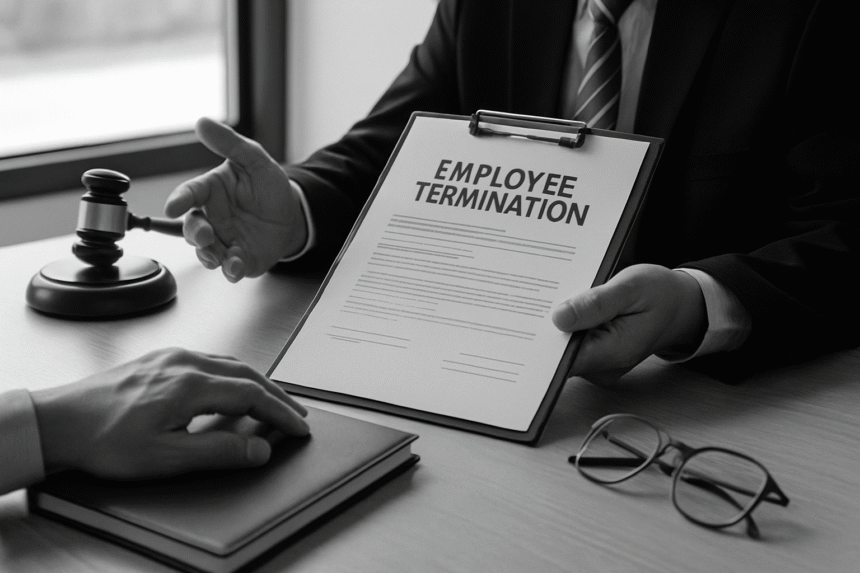Employer termination mistakes can lead to lawsuits, reputational damage, and serious compliance issues. Yet many businesses continue to handle terminations poorly—rushing through the process, ignoring employment contracts, or skipping required notices.
Whether you’re firing for cause, downsizing, or ending a trial period, each termination must be handled carefully. In this article, we’ll walk you through 7 common termination mistakes employers make, how to avoid them, and how to protect your business legally and ethically.
Who This Is For / Why This List Matters
This article is designed for:
-
Startup founders and small business owners
-
HR managers and internal compliance teams
-
Legal professionals handling employment law
-
Team leads responsible for dismissal decisions
Use this list when:
-
You’re planning to terminate an employee
-
You’re restructuring, reducing headcount, or ending a probationary hire
-
You want to minimize liability and remain legally compliant
1. Mistake #1: Failing to Document Performance Before Termination
One of the most critical mistakes employers make during employee termination is failing to keep proper documentation of employee performance or behavior.
✅ Why it matters:
Without written records of warnings or underperformance, it’s difficult to justify termination legally. This can be used against you in wrongful dismissal claims.
📝 What to do instead:
-
Maintain detailed records of meetings, feedback, and performance reviews
-
Use formal performance improvement plans (PIPs) where necessary
-
Save internal notes, emails, or written warnings related to conduct or output
2. Mistake #2: Ignoring Employment Contracts or Policies
Another frequent employer termination mistake is disregarding the employment contract or internal HR policy.
✅ Why it matters:
Contracts may include mandatory notice periods, severance provisions, or due process requirements. Ignoring these can result in legal penalties or breach of contract claims.
📝 What to do instead:
-
Always review the employment agreement before initiating termination
-
Check policies on misconduct, notice, and grievance procedures
-
Consult legal counsel if unsure about what’s enforceable
3. Mistake #3: Not Providing Legally Required Notice or Payment in Lieu
Among the most costly employer termination mistakes is forgetting or miscalculating notice periods.
✅ Why it matters:
Even in at-will environments, laws or contracts may require notice or compensation. Non-compliance often leads to fines or lawsuits.
📝 What to do instead:
-
Refer to local labor laws and contract terms for minimum notice
-
If offering payment in lieu, calculate accurately (including benefits)
-
Always include the final pay terms in the termination letter
4. Mistake #4: Mishandling the Termination Conversation
How you conduct the termination conversation matters as much as the decision itself. Poor delivery is one of the more avoidable employer termination mistakes.
✅ Why it matters:
A disrespectful or confusing termination meeting can escalate tension, cause reputational damage, or trigger retaliation.
📝 What to do instead:
-
Prepare talking points and necessary documents in advance
-
Have a neutral HR representative present
-
Keep the tone professional and avoid blaming or debating
5. Mistake #5: Delaying Final Pay, Benefits, or Accrued Leave
Another one of the common mistakes employers make during employee termination is mishandling final payments.
✅ Why it matters:
Laws often require that employees be paid within a specific timeframe. Delays or missing entitlements can result in penalties or labor board complaints.
📝 What to do instead:
-
Prepare final paycheck to include unused vacation and bonuses
-
Explain benefit continuation options (like COBRA or local equivalents)
-
Deliver payment promptly and document the transaction
6. Mistake #6: Skipping the Termination Letter
Surprisingly, many employers fail to provide a formal termination letter. This is one of the simplest employer termination mistakes to avoid.
✅ Why it matters:
Verbal termination can lead to misunderstandings. Without written confirmation, you risk confusion and legal ambiguity.
📝 What to do instead:
-
Provide a signed termination letter with reason, final pay info, and return-of-property instructions
-
Use clear language and avoid admitting liability
-
Retain a copy for your HR or legal records
7. Mistake #7: Overlooking Post-Termination Responsibilities
The final and often ignored mistake employers make during employee termination is failing to handle post-exit obligations.
✅ Why it matters:
Former employees may retain access to data, violate non-competes, or misuse client information if protocols aren’t enforced.
📝 What to do instead:
-
Collect all company property (laptops, ID cards, files)
-
Remind the employee of ongoing confidentiality or non-compete obligations
-
Conduct a proper exit interview and offboarding checklist.
📄 Mini Case Example: Termination Without Notice Backfires
An early-stage tech company terminated a developer abruptly without reviewing the employment contract. The founder assumed no notice was required, but the contract clearly included a 2-month notice period.
Three weeks later, the employee filed a claim for wrongful termination. The court awarded damages exceeding the unpaid salary due to breach of contract.
👉 Lesson: Avoiding basic mistakes during employee termination mistakes—like ignoring notice clauses—can turn into costly legal errors.
Termination Risk Checklist
Use this quick checklist to avoid critical employer termination mistakes:
-
Have you documented performance or misconduct properly?
-
Have you reviewed the employment contract and internal policies?
-
Are you complying with notice requirements or offering proper pay in lieu?
-
Have you planned a respectful, compliant termination conversation?
-
Are you issuing final pay and outlining benefits clearly?
-
Have you prepared and delivered a termination letter?
-
Have you completed post-exit procedures (offboarding, access removal)?
Closing Thoughts + Call-to-Action
By understanding the 7 mistakes employers make during employee termination, you’ll reduce legal risk, preserve your reputation, and ensure a smoother offboarding process.
👉 Want to make sure your company’s termination process is legally compliant?
Book a consultation or download our free Employee Termination Checklist today.



Leave a Reply